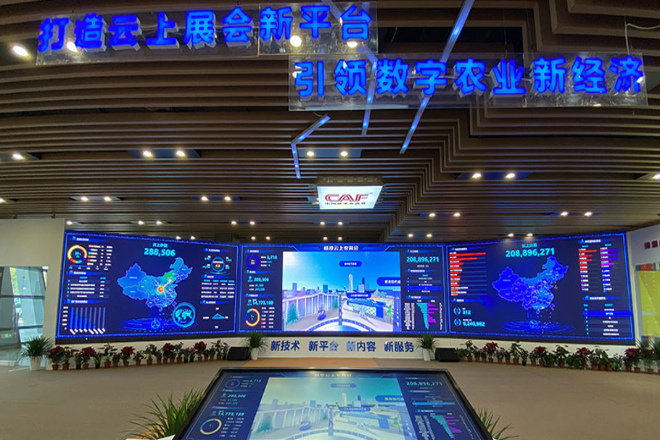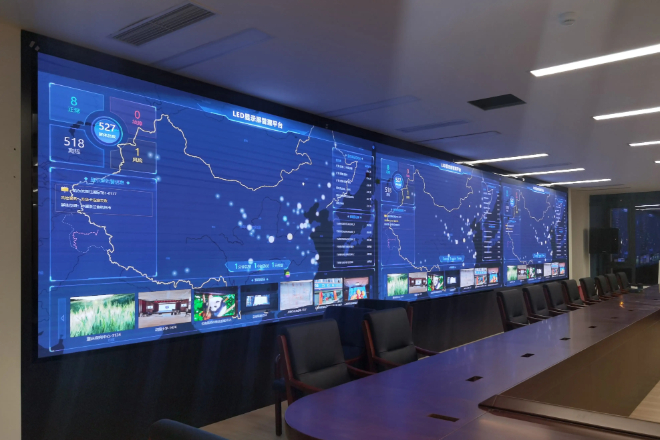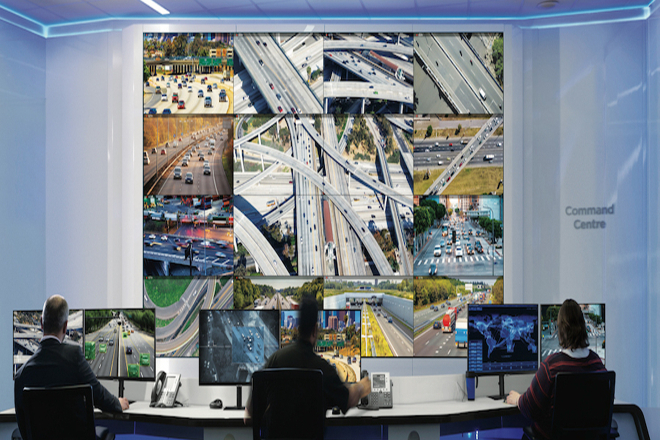Introduction
Cameras and various monitoring equipment can be seen everywhere now, but do you know? LED display is not only used for advertising. It can also show its prowess in security monitoring.
Don’t underestimate it. It can help us with many things, from real-time monitoring to alarm reminders to data analysis. It is simply an “all-round assistant”. Come and see how it does it!
Table of Contents
1. The current situation and demand for smart security monitoring management
Nowadays, smart security monitoring is developing very fast. Technically, new technologies such as artificial intelligence and the Internet of Things are used, and monitoring equipment is becoming more and more intelligent.
For example, cameras can not only take pictures, but also automatically identify abnormal situations.
There are also more application scenarios. In addition to common communities and shopping malls, they also show their prowess in industries, transportation, and other fields.
The policy is also very powerful, promoting the construction of smart communities and encouraging the use of smart security equipment.
However, there are also problems, such as the slow construction of some large projects last year, fierce competition in the industry, and enterprises must find their own positioning and market.
Nowadays, people’s requirements for smart security monitoring are getting higher and higher. First, it must be able to monitor in real-time. Once there is an abnormality, such as someone breaking in or a fire, the system must immediately alarm and notify relevant personnel to handle it.
Secondly, the monitoring information must be intuitive, and the staff must not be confused by the screen. It is best to display it through charts, maps, etc.
In the event of an emergency, the system must be able to assist in command and dispatch, such as displaying the scene and personnel distribution, to facilitate quick decision-making.
Afterward, it must be able to trace the course of the incident through data analysis and summarize lessons learned.
In the future, intelligence and automation are the general trend. The security system must be able to integrate with other systems, such as smart home and smart transportation, to provide a more comprehensive solution.
2. Specific application of LED display screens in intelligent security monitoring management

1). Real-time monitoring and information display
Imagine that there are dozens of cameras working at the same time in the monitoring room.
If there is no good screen, the monitoring personnel will be dazzled.
The power of LED display screens lies in that it can display the images of multiple cameras on a large screen at the same time through splicing technology.
For example, in a large shopping mall, the monitoring personnel can sit in front of the screen and see the pictures of each floor and each corner, so they don’t have to worry about missing important situations.
Moreover, the current LED display has a very high resolution and can support high-definition or even ultra-high-definition video signals.
This means that no matter how complex the picture captured by the camera is, it can be clearly seen on the LED screen without blur.
For example, in some scenes that require face recognition, the high-definition picture allows the monitoring personnel to clearly see the details of the face and reduce misjudgment.
What’s more, the refresh rate of the LED display is very fast, and the picture can be updated in real time. This ensures the monitoring information is in real-time and that the monitoring personnel always see the latest situation.
For example, at a traffic intersection, vehicles and pedestrians are constantly flowing, and the LED screen can refresh quickly to reflect the changes in road conditions in a timely manner.
Another practical function is information overlay and annotation. While displaying the monitoring picture, the LED display can overlay information such as time, location, camera number, etc., in the corner or above the picture.
In this way, when the monitoring personnel look at the picture, they can quickly know where and when the picture was taken, which is convenient for recording and subsequent search.

2). Command and dispatch and decision support
In some large monitoring areas, such as industrial parks or large event venues, the commander needs to quickly understand the situation of the entire area.
At this time, the LED display can display the floor plan or layout of the monitoring area, and the commander can see the location of each monitoring point at a glance and have a clear mind.
If combined with the positioning system, the LED display can also display the real-time location of the monitoring target (such as security patrol personnel and vehicles).
The commander can accurately dispatch personnel and vehicles based on this information.
For example, if an abnormal situation is found in a certain area, the commander can immediately see which security guards are nearby through the screen, and then quickly command them to check.
In addition, the LED display can also be used to issue command orders. The commander can send instructions to the on-site personnel through the screen, and the on-site personnel can also give feedback on the situation through the screen to achieve two-way interaction.
It’s like the commander has “clairvoyance” and “wind hearing”, which can better control the overall situation.
The most powerful thing is that when an emergency occurs, the LED display can display information such as emergency plans, evacuation routes and rescue guides.
For example, in the event of a fire, the screen can clearly show the location of the nearest safe exit, guiding the on-site personnel to evacuate quickly and reduce danger.
3). Alarm and notification function
In security monitoring, it is particularly important to detect abnormal situations in time. LED display screens also play a big role in this regard.
When the monitoring system detects abnormal events, such as someone breaking into a restricted area, a fire, or a gathering of people, the LED display screen can immediately switch to alarm mode.
The screen will display eye-catching alarm information, such as the red word “alarm”, to remind the monitoring personnel to pay attention.
In emergency situations, LED display screens can also issue emergency notifications.
For example, if a suspicious person is found in a shopping mall, the monitoring personnel can issue a notification to the customers in the mall through the screen to remind them to pay attention to safety or guide them to evacuate.
In addition, the LED display screen can be linked with other devices in the security system. For example, it can be linked with the alarm. Once the alarm is triggered, the screen will immediately display the alarm location.
It can be linked with the access control system, which responds in a graded manner according to the severity of the incident.
In this way, the entire security system is like a closely coordinated team that can quickly and efficiently handle various emergencies.

4). Data visualization and analysis
Security monitoring will generate a large amount of data, such as personnel flow, vehicle traffic records, alarm event statistics, etc. If these data are just piled up there, it is difficult to play a role.
But LED display screens can display these data in the form of charts, images or maps, so that monitoring personnel can see them at a glance.
For example, by showing the daily changes in personnel flow through bar charts and showing crowded areas through heat maps, monitoring personnel can quickly understand the overall situation of the monitoring area.
Moreover, LED display screens can also play back historical monitoring videos to analyze and investigate events. For example, if a theft occurs, monitoring personnel can play back the video on the screen to find the cause and responsibility of the incident.
What’s more, combined with data analysis technology, LED display screens can also display data mining results and trend prediction information.
For example, based on the changing trend of personnel flow, predict the peak hours that may occur in the future and prepare in advance. This is equivalent to providing security managers with an “intelligent assistant” to help them find problems in advance and optimize security strategies.
6). Integrated application with other security systems
LED display screens can not only work independently but also seamlessly connect with other security systems.
For example, it is integrated with high-definition cameras and intelligent analysis equipment to achieve real-time display of monitoring images and visualization of intelligent analysis results.
After intelligent analysis, the images captured by the camera are directly displayed on the LED screen. The monitoring personnel can see whether the people in the picture have suspicious behavior, whether the vehicle has violated the regulations, etc.
After integration with the access control system, the LED display screen can display information such as personnel entry and exit records and access control status.
For example, at the company gate, the screen can clearly display who enters and who leaves, which is convenient for access control management.
After integration with the alarm system, the LED display screen can receive alarm signals and display the alarm location and event type in real-time, allowing monitoring personnel to respond quickly.
In the traffic monitoring scene, the LED display screen is integrated with the intelligent traffic system to display data such as traffic flow, road conditions, and illegal capture.
For example, in the traffic command center, the traffic flow at each intersection can be seen on the screen. Once congestion is found, the command personnel can adjust the signal lights in time to relieve traffic pressure.
In short, the LED display screen is like a “super brain” in intelligent security monitoring management.
It can not only display the monitoring screen in real-time but also assist in command and dispatch, issue alarms, analyze data, and work closely with other systems, greatly improving the efficiency and effectiveness of security monitoring.
3. Advantages of LED display screens in intelligent security monitoring management
LED display screens have many significant advantages in intelligent security monitoring management.
These advantages not only improve monitoring efficiency and enhance security, but also optimize the entire monitoring management process, making it an indispensable and important part of modern security systems.
1). Improve monitoring efficiency
1.1). Multi-screen splicing technology:
The splicing technology of LED display screens is very powerful, and it can display images of multiple surveillance cameras on a large screen at the same time.
In this way, monitoring personnel do not need to frequently switch screens or view multiple small screens, which greatly reduces the workload and improves work efficiency.
For example, in the monitoring center of a large factory, through splicing technology, monitoring personnel can see the images of multiple key areas such as workshops, warehouses, and gates on a large screen at the same time, and easily grasp the overall situation.
1.2). Real-time monitoring and rapid response:
The refresh rate of LED display screens is extremely high, and they can display monitoring information in real time. Monitoring personnel can detect abnormal situations and deal with them quickly at the first time to avoid the expansion of problems.
For example, in traffic monitoring, once a traffic accident or traffic congestion occurs, the monitoring personnel can immediately see it and dispatch traffic police to deal with it in time.
1.3). Centralized information display:
LED display screens can display a variety of monitoring information on one screen, such as video images, alarm information, personnel location, etc.
This avoids the information being scattered on different devices, and monitoring personnel can quickly obtain comprehensive information and improve work efficiency.
For example, in the monitoring center of a large shopping mall, one screen can display all important information, which is convenient for monitoring personnel to make decisions quickly.
2). Enhanced monitoring security
2.1). High definition and detail presentation:
The high resolution and high definition technology of LED display screens allow monitoring personnel to clearly see the details in the picture.
For example, in the face recognition system, high-definition images can accurately display facial features, help monitoring personnel discover potential safety hazards, and reduce misjudgments.
2.2). Remote monitoring and management:
Through network technology, LED display screens support remote monitoring and management.
Monitoring personnel can view monitoring images far away from the site, reducing the risk of exposure of on-site personnel, especially in some dangerous environments (such as chemical plants and mines). This function is very important.
2.3). Data encryption and secure transmission:
LED display screens support data encryption and secure transmission technology to ensure that monitoring information is not stolen or tampered with during transmission.
This is crucial to protect the security of monitoring data in important places (such as financial institutions and government agencies).
3). Optimize monitoring management
3.1). Centralized control and management:
Through the centralized control system, monitoring personnel can uniformly manage LED display screens and peripheral equipment, such as cameras, alarms, etc.
For example, in a large security system, one console can operate all equipment, which is convenient and fast.
3.2). Authority management and hierarchical monitoring:
LED display screens can achieve hierarchical monitoring and management according to different user permissions.
For example, ordinary monitoring personnel can only view the screen, while senior management personnel can operate the equipment and adjust parameters, which ensures information security.
3.3). Intelligent operation and maintenance and fault warning:
LED display screens support intelligent operation and maintenance management systems, which can monitor the status of equipment in real-time.
Once an abnormality is found, the system will issue an early warning to remind maintenance personnel to deal with it in time, reduce equipment downtime, and ensure the stable operation of the monitoring system.
In general, LED display screens not only improve work efficiency in intelligent security monitoring management, but also enhance security and optimize management processes.
These advantages make it an indispensable and important tool in modern security systems.
4. Which LED display screens are suitable for use in intelligent security?
1). High-resolution LED display screen
- Features:
High-resolution display screens (such as 4K and 8K) can present extremely delicate pictures with clear details. This type of screen has a high pixel density, which can maintain the clarity and sharpness of the image even on a large screen.
- Advantages:
In security monitoring, high-resolution screens can significantly improve the accuracy of monitoring.
For example, face recognition systems require high-resolution screens to clearly display facial details, thereby reducing misjudgments; license plate recognition systems also require high resolution to capture the text on license plates.
2). Small-pitch LED display screen
- Features:
The pixel pitch of small-pitch LED display screens is small, usually between 1.2mm and 2.5mm. The picture of this screen is delicate and suitable for close viewing, and there will be no obvious graininess even at close range.
- Advantages:
Small-pitch screens perform well in scenarios where high-density display information is required.
For example, in the monitoring room, the small-pitch screen can clearly display the images of multiple cameras and various monitoring data.
In the conference room, the small-pitch screen can be used to display high-definition charts and documents.
3). Recommendations for selecting LED display screens
When selecting LED display screens for use in smart security, the following factors need to be considered comprehensively:
- Application scenario:
Select the appropriate screen type according to the specific monitoring scenario.
For example, outdoor scenes require waterproof and dustproof screens, while indoor monitoring centers require high-resolution or large-size splicing screens.
- Monitoring requirements:
Clarify the requirements of the monitoring system, such as whether real-time data analysis is required, whether high-precision display is required, etc., to select screens with corresponding functions.
- Budget:
The prices of different types of LED display screens vary greatly, and it is necessary to select cost-effective products according to the budget.
- Maintenance cost:
Consider the durability and maintenance cost of the screen, and choose products with reliable quality and easy maintenance.
In short, the LED display screen in smart security should not only look good but also be easy to use. Choosing the right screen type can significantly improve the effect and efficiency of security monitoring.
5. Conclusion
Okay, today we will talk about the application of LED display screens in smart security!
Do you think it is amazing? In fact, the power of technology lies in helping us do things smarter and more efficiently.
LED display is such a good helper, which not only allows us to see more clearly, but also makes management easier.
Finally, if you want to know more about LED displays, please get in touch with us.
